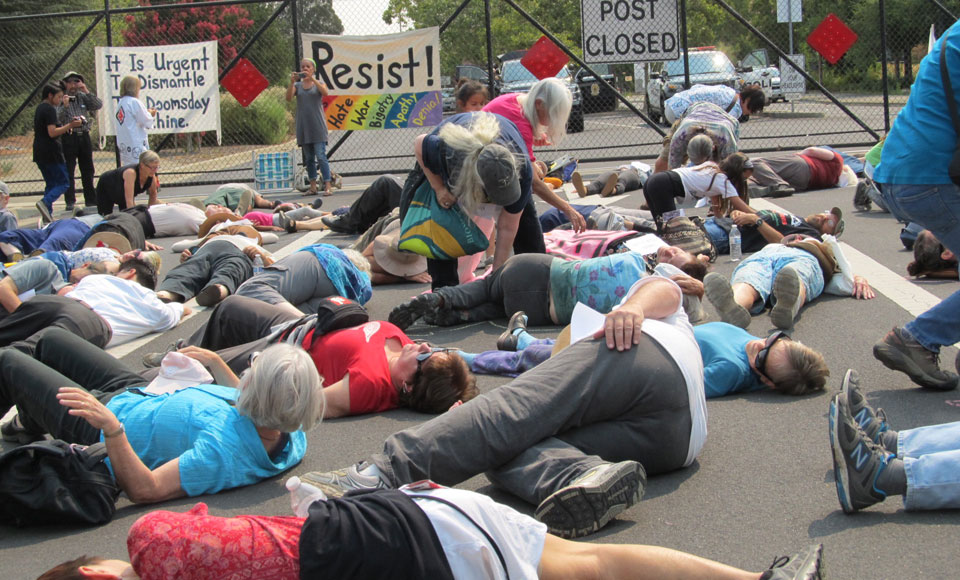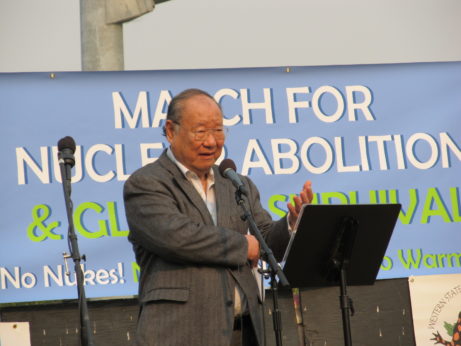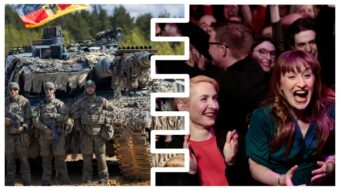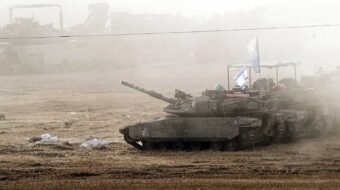
LIVERMORE, Calif.—Hundreds gathered outside the Lawrence Livermore National Laboratory here Aug. 6, to mark the 73rd anniversary of the devastating U.S. nuclear bombing of the Japanese cities of Hiroshima and Nagasaki, and to pledge a greatly stepped-up fight to abolish nuclear weapons worldwide.
Peace advocates see global nuclear disarmament as an ever more urgent issue now, in the face of the Trump administration’s Nuclear Posture Review, released last February.
Rally speakers brought the demonstration’s call to action—No Nukes! No Walls! No Wars! No Warming!—to life as they linked today’s urgent struggles and examined decades of historical context.
Keynote speaker Daniel Ellsberg, the whistleblower whose 1971 release of the Pentagon Papers helped speed the end of the Vietnam War, highlighted the concept of “time, time enough, and too late” in relation both to climate change and nuclear apocalypse.
He linked the alarms raised by climate scientists who see looming “tipping points” after which change is impossible, with Martin Luther King Jr.’s April 1967 observation concerning nuclear weapons: “There is such a thing as too late.”
Illustrating his point with accounts of the captain of the Titanic sealing his ship’s doom by ignoring repeated warnings, and the choices which might have averted total nuclear devastation of Hiroshima and Nagasaki, Ellsberg said, “The meaning I draw from it is, every minute we have here is precious, everything is at stake, we don’t know if it is too late to keep those trees from dying in a nuclear winter. That means each of us has the opportunity to do what we can to postpone that, avert that, make it less likely forever. And that is worth doing.”
He called on the crowd “to act as if we still have time to change this. We don’t know otherwise; it’s impossible to say it’s too late at any given point.”
The Rev. Nobuaki Hanaoka, a retired Methodist minister now living in the San Francisco Bay Area, was an infant in Nagasaki on August 9, 1945, the day the U.S. unleashed on that city the second of its nuclear bombs.
Within the first year, he said, the death toll from the two bombings had climbed to a quarter million. The blast knocked down nearly every building within a two-mile radius, and people were crushed by falling buildings and struck by flying debris. Then came the immense fireball, with a surface temperature of 10,000 degrees Fahrenheit.
“More insidious and deadlier was the nuclear radioactive fallout spreading into the atmosphere over the wider area,” Hanaoka said. “And death came down with the rain.”
Though Hanaoka’s family was living outside the city, in the years that followed his mother and then his sister died of leukemia. When his brother died years later at an early age, an autopsy showed his internal organs to be like those of an 80-year-old man. As a child, Hanaoka overheard a doctor say that he himself might not live to see his tenth birthday.
“If the Hiroshima bomb, a rudimentary small bomb, inflicted so much pain and suffering for so long,” he said, “who can imagine what these new weapons can do to us? Disaster is not the word, it’s a global suffering, global crime.”
Hanaoka called on President Trump to bring all nine nuclear states together “and start discussing dismantling all these criminal weapons.”
Family separation was one theme for Christine Hong, a faculty member at the University of California, Santa Cruz, who focuses on transnational Asian-American issues, the Korean diaspora, and critical Pacific Rim studies.
She pointed out that the Korean War in 1950-53, which has never been ended with a peace treaty, “ensured that one in three Korean families was separated. We’re not talking about separation of a matter of months—we’re talking about separation that has lasted for seven decades.”
“In the U.S.,” she said, “there are over 100,000 Korean Americans—you probably know some and you’re talking to one, too—who have family members in the North.”
Observing that recent developments on the Korean peninsula, including the coming together of the two Koreas, are making this a very different time than a year ago, Hong said, “Peace in Korea has appeared, amazingly, as a prospect on the horizon,” but reminded the crowd that in the absence of a peace treaty the countries that signed the armistice agreement, North Korea, China, and the U.S., are all responsible to hammer out a peace agreement.
She cited two critical issues: whether the U.S. and North Korea have the same understanding of denuclearization, and whether the two countries “have the same concept of peace—it’s not just denuclearization, it’s peace.”
Hong called on the crowd to help to build a people’s movement for peace with North Korea, “which has never existed,” and to think of “the people in their communities who have been part of separated families for over seven decades.”
Also speaking were Robert Gould of Physicians for Social Responsibility, Pennie Opal Plant of Idle No More SF Bay, and Marylia Kelley, executive director of Tri-Valley Communities Against a Radioactive Environment, which together with the Livermore Conversion Project was a major organizer of the action.

The Oakland-based hip-hop collective The Oakland Mind galvanized the crowd as it expressed the demonstration’s goals through its music.
The rally ended with a heartfelt call for peace from young people ages two to 11, who participated in a family peace camp over the preceding weekend, and with a stirring Call to Action delivered by Jacqueline Cabasso, executive director of the Western States Legal Foundation.
Cabasso announced that anti-nuclear activists were forming a contingent to join the Sept. 8 Rise for Climate, Jobs, and Justice march in San Francisco.
She reminded the crowd that the Bulletin of the Atomic Scientists earlier this year moved the hands of its Doomsday Clock to 2 seconds to midnight—30 seconds closer than before and as close as it has ever been since its inception in 1947. In doing so, she said, the Bulletin cited the failure of President Trump and other world leaders to deal with looming threats of nuclear war and climate change and declared “the world is as threatened as it has been since World War II.”
“Preparations for nuclear war are underway here at the Livermore Lab,” Cabasso said, noting that 89 percent of the lab’s budget for fiscal year 2019 is dedicated to nuclear weapons activities including developing new ones.
“But in this time of multiple global crises, our work for the elimination of nuclear weapons takes place in a broader context,” she said, “with the interface between nuclear and conventional weapons, the humanitarian and environmental consequences of nuclear war, and the fundamental incompatibility of nuclear weapons with democracy, the rule of law, and human wellbeing.”
Demonstrators then marched to the West Gate of the Livermore Laboratory, where they participated in a Japanese ceremonial dance, held a “die-in” and left chalk outlines of their bodies near the Lab entrance, and witnessed or joined in the voluntary arrests of some 40 protesters, who were cited and released.
Actions were held around the country, including at the Y-2 plant in Tennessee, the Los Alamos Lab in New Mexico, the Rocky Flats Plant in Colorado, and Santa Barbara, Calif., with overall sponsorship of the Alliance for Nuclear Accountability, a network of three dozen groups based near U.S. nuclear weapons sites.











